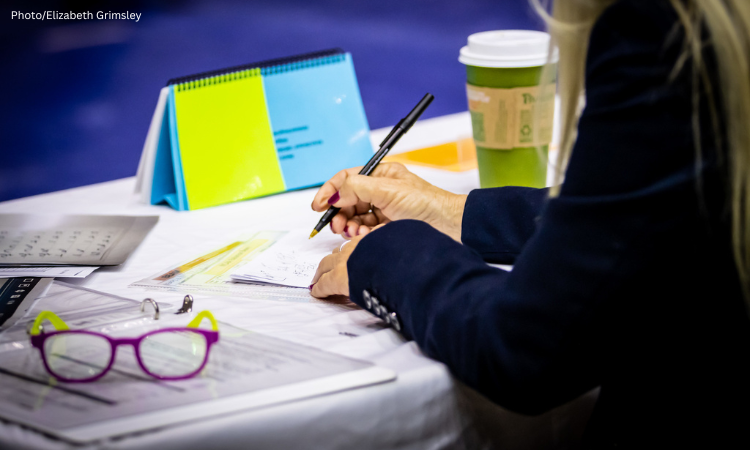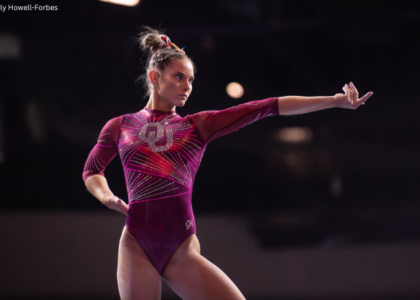This season we have seen literally hundreds of 10.0s flashed from at least one judge, which could be attributed to an increase in the caliber of NCAA gymnastics, as well as judges becoming increasingly forgiving of the small errors they either overlook or disregard. As a former NCAA judge, I can understand the pressures of seeing maybe two half-tenth deductions for flexed feet and wondering, “Were they really flexed?” as the entire arena chants for a “10!” No one wants to be the judge to disappoint thousands of spectators in the stands and at home.
On the flip side, judges may take a deduction that might not be there for fear of giving a 10 on an obviously not-10 routine, even if their notes say otherwise. Even if the judge didn’t have any deductions on the paper, they had to have missed something, right? Maybe going 9.950 just in case is the safer bet.
Unfortunately, this pressure is what NCAA judges signed up for, and I commend those judges that confidently flash the score from an appropriately evaluated routine, even if it’s unpopular. In this article, we’ll take another look at some of those near-perfect 9.975s to see which judge was correct in their assessment.
Vault
Chase Brock (LSU)
Yurchenko one and a half
Deductions
Trunk movement to maintain balance (-0.050)
Deep squat on landing (-0.050)
Brock looks beautiful in the air with great height, rotation, and body position. She landed a little low in her squat, with the ideal landing position having a 45-degree knee bend with the chest leaning forward at 45 degrees, parallel to the lower leg. Here you can she’s at about a 90-degree squat, with her chest upright and back over her heels. She also leans forward with her heels coming up off the mat to maintain her stick, which is also a deduction.
My Score: 9.900
Mackenzie Wilson (Kentucky)
Front handspring pike half
Deductions
Shoulder angle (-0.050)
Excessive Arch (-0.050)
Wilson’s vault is a beautifully executed vault with a gorgeous landing. The only break I see, and that I see on almost every front handspring front pike half (except Haleigh Bryant), is an arch and shoulder angle on the table. This is a commonly used technique that helps to generate more power, but unfortunately it’s also a deduction.
My Score: 9.900
Linda Zivat (Iowa)
Tsuk Full
Deductions
Leg separation (-0.050)
Pike down (-0.050)
I always love seeing a good Tsuk full, and Zivat has a great one. She has a small bit of leg separation that may have been missed in full speed, but she does break her layout shape at the end and pike down to complete her rotation.
My Score: 9.900 to 9.950
Jordan Chiles (UCLA)
Yurchenko Double
Watch the Vault (Another angle)
Deductions
Arm bend (-0.050)
Prescribed LA turn begun too early (-0.050)
Crossed legs (-0.050)
Chiles’ Yurchenko double is one of the most consistent, and hardest, vaults being performed in NCAA gymnastics. In this iteration, you can see that she twists early, which causes her to bend one of her arms on the table and start to turn her shoulders before she completes her block. At full speed, it’s hard to process what exactly looks wrong with the block, but a judge could tell that the block looks “off.” Since it would be hard to break down both errors (arms and twist) at full speed, I don’t think she’d get more than a half tenth (assuming they took anything). She also has some minor leg crossing in the air, and depending on the angle and timing of the crossed legs, the judges may or may not have been able to see if from their angle.
My Score: 9.900 to 9.950
Bars
Cassidy Rushlow (Penn State)
Deductions
Body position (-0.050)
Giant swings x2
Flexed feet (-0.050)
Bent legs (-0.050)
When I judge bars, it’s impossible for my brain to register amplitude/angles, body position, and arm and leg form simultaneously while writing down the skill that they are doing and then writing down each deduction, all before she does the next skill. After over a decade of judging, I can look at the skill holistically and say, “That’s a tenth. That’s a half a tenth. Etc.”
So for Rushlow’s body position, I would look at it and say, “That’s a half a tenth,” but if you asked me why in real time, I wouldn’t be able to tell you.
After reviewing her shoot over, the amplitude is borderline (she needs to be above horizontal to avoid a deduction), she also has some soft elbows, and her hips are a little twisted and a little piked. There’s no way I would take a half a tenth for every one of those errors, but holistically, I would take a half a tenth on her general positioning.
Her giant swings could incur a one-tenth deduction each for her flexed feet past the low bar and bent knees in her taps, but these are hard to see in real time and one of the most commonly “forgiven” bar deductions.
My Score: 9.850 to 9.950
Lali Dekanoidze (North Carolina)
Deductions
Leg separation (-0.050)
Arm bend (-0.050)
Body shape (-0.050)
Dekanoidze has consistently been one of the best bar workers in the NCAA this year. Her routine had a couple small errors that are not often taken in NCAA but are still deductions. Her Maloney had some leg separation, but as we know, judges struggle to see leg separation from the side view. As a side note, the code states that “bent arms” is a deduction in “support,” so I don’t believe bending her arms like in the screenshot above (or on similar skills like Tkachevs) would be a deduction since it’s part of the release.
Her giant swings, while allowed to have a rounded shape to generate power for her dismount, seem more piked than round. As she shifts her hands over the bar, her arms bend in support. These are all very minor errors that are consistently forgiven in NCAA. This would have been a three-star 10.0 if both judges had gone 10.0, so I think 9.975 is an appropriate score and in line with how bars has been judged nationally this season.
My Score: 9.900
Beam
Mia Takekawa (Illinois)
Deductions
Bent arms (-0.050)
Balance error (-0.050)
Balance error (-0.050)
I’m not sure how, but Takekawa definitely saved her acro series from a potential fall. In the process, she did bend her arms and have a slight balance check to pull her body back into alignment over the beam. She also overturns her full turn slightly, resulting in a small wobble. On a side note, Takekawa proves that it is possible to point your toes in a side aerial on beam, which I wasn’t sure was possible given the number of aerials with flexed feet that have gone 10.0 this year. Thank you for settling that debate for me, Mia!
My Score: 9.850
Gabby Wilson (Michigan)
Deductions
Leg bend (-0.050)
Balance check (-0.050)
Wilson does the best double flipping dismount off beam I have seen this season, with great height, rotation, and a stuck landing with her chest up. The only thing I saw was a slight leg bend in her back handspring, and like Takekawa above, Wilson also over turns and wobbles slightly on her full turn.
My Score: 9.900
Floor
Chloe Negrete (N.C. State)
Deductions
Small foot adjustment (-0.050)
Front Layout (B)
Body position (-0.050)
Small front foot adjustment (-0.050)
Negrete has some of the best dance passes on floor, with a beautiful stand-alone tour-jetè full in addition to her dance pass. The only deductions I saw were small foot adjustments on both of her back tumbling passes, which could have easily been missed by the judges depending on how far they were sitting from the landing and if her foot movement was covered by the depression of the mat. The double pike landing error would have been especially hard to see. She had a slight pike as well into her front layout on her second pass, which could be a body position error, but this pike-whip front layout technique is used by many NCAA gymnasts, likely without deduction.
My Score: 9.900
Keanna Abraham (UC Davis)
Watch the Full Routine (1:06:50)
Deductions
Leg separation, back handspring (-0.050)
Leg separation, double layout (-0.050)
Pike body position (-0.050)
Front full (C)
Leg Separation (-0.050)
Leg separation (-0.050)
Step, front foot (-0.050)
Abraham is a powerful tumbler with a huge double layout, but she does have some leg separation throughout her routine on both of her back handsprings, her front full, and her double layout. It also looks like her feet may be flexed in her back handsprings as well, but I’m not sure if the judges would see that from across the floor in real time. If you overlook these small form breaks, she also bobbles the landing of her last pass and has to step her front foot slightly to the side to regain her balance. With a little more polish on the details of her tumbling, this routine could easily be a 10 for UC Davis.
My Score: 9.700
READ THIS NEXT: Judge’s Inquiry: Breaking Down February’s Perfect 10s Part 2
Article by Rhiannon Franck
Rhiannon Franck is a former national-rated NAWGJ women’s gymnastics judge with over 15 years of USAG judging experience and nine seasons judging NCAA gymnastics. Outside of gymnastics, Franck works at a university as a nursing professor and loves to travel. You can follow her on Instagram and Twitter.
Like what you see? Consider donating to support our efforts throughout the year!





One comment